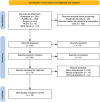Simulating space walking: a systematic review on anti-gravity technology in neurorehabilitation
- PMID: 39272129
- PMCID: PMC11395184
- DOI: 10.1186/s12984-024-01449-z
Simulating space walking: a systematic review on anti-gravity technology in neurorehabilitation
Erratum in
-
Correction: Simulating space walking: a systematic review on anti-gravity technology in neurorehabilitation.J Neuroeng Rehabil. 2024 Oct 18;21(1):186. doi: 10.1186/s12984-024-01472-0. J Neuroeng Rehabil. 2024. PMID: 39425113 Free PMC article. No abstract available.
Abstract
Neurological disorders, such as Parkinson's disease (PD), multiple sclerosis (MS), cerebral palsy (CP) and stroke are well-known causes of gait and balance alterations. Innovative devices (i.e., robotics) are often used to promote motor recovery. As an alternative, anti-gravity treadmills, which were developed by NASA, allow early mobilization, walking with less effort to reduce gait energy costs and fatigue. A systematic search, according to PRISMA guidelines, was conducted for all peer-reviewed articles published from January 2010 through September 2023, using the following databases: PubMed, Scopus, PEDro and IEEE Xplore. After an accurate screening, we selected only 16 articles (e.g., 5 RCTs, 2 clinical trials, 7 pilot studies, 1 prospective study and 1 exploratory study). The evidence collected in this systematic review reported promising results in the field of anti-gravity technology for neurological patients, in terms of improvement in gait and balance outcomes. However, we are not able to provide any clinical recommendation about the dose and parameters of anti-gravity treadmill training, because of the lack of robust high-quality RCT studies and large samples. Registration number CRD42023459665.
Keywords: Anti-gravity technology; Anti-gravity treadmill; Neurological disorders; Neurorehabilitation.
© 2024. The Author(s).
Conflict of interest statement
The authors declare no competing interests.
Figures




References
-
- Iandolo R, Marini F, Semprini M, Laffranchi M, Mugnosso M, Cherif A, et al. Perspectives and challenges in Robotic Neurorehabilitation. Appl Sci. 2019;9:3183. 10.3390/app9153183.
-
- Molteni F, Gasperini G, Cannaviello G, Guanziroli E. Exoskeleton and End-Effector Robots for Upper and Lower limbs Rehabilitation: Narrative Review. PM R. 2018;10(9 Suppl 2):S174–88. 10.1016/j.pmrj.2018.06.005. - PubMed
Publication types
MeSH terms
LinkOut - more resources
Full Text Sources
Research Materials
Miscellaneous

